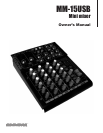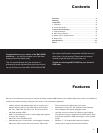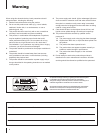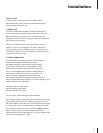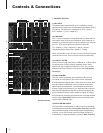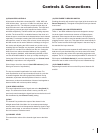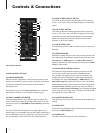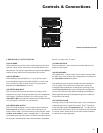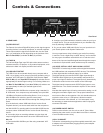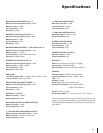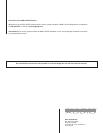
6
Controls & Connections
(6) EQUALIZER CONTROLS
All channels are fitted with a three-band EQ - HIGH, MID, and
LOW. All three bands have up to 15 dB of cut and boost, with a
center detent for OFF. The frequency response is flat when all
three EQ knobs are in the center detent position. The HIGH and
LOW shelving controls have their frequencies fixed at 10KHz
and 80Hz respectively. The MID control has a peaking response
at 2KHz. The channel EQ is a valuable feature of the mixer as it
allows the user to control the tonal characteristics of each channel
separately. For example, boosting the LOW can fatten the sound,
add warmth to vocals, or extra punch to bass, drums and synths;
the MID control can be used to define the midrange or bring out
the vocals; and adjusting the HIGH control can provide a crisp
sounding high end. Another very important, yet often overlooked
technique is to use the EQ to subtract from the mix. Cutting the
HIGH control can reduce unwanted sibilance, hiss, cymbals,
or high frequency feedback, while attenuating the MID or LOW
can also eliminate feedback or clear up a muddy sounding mix.
Cutting the HIGH and LOW, then pushing up the Channel Level
Control(6) is equivalent to mid range boost!
[Note: Always check the channel’s Peak LED Indicator(5) after
altering the amount of equalization].
The key to successful equalization is to avoid excess. Too
much equalization on the input channels will result in a mix that
is smeared together with nothing specifically defined. During
rehearsals, experiment with the equalizer controls on various
instruments, vocals and combinations of these mixed together to
become familiar with various equalizer settings.
(7) AUX SEND CONTROL
This control adjusts the level of signal sent to the Aux Send(23)
output. The channel Aux Send control is mono, post-EQ, and
post-Level control meaning the signal level sent to the Aux bus will
also be affected by the Channel Level(9) setting.
(8) PAN
The channel Pan positions the output of the channel in the
left/right stereo field of the Main mix. Its constant-power design
ensures there are no level discrepancies whether a signal is hard-
panned, center-stage, or somewhere in-between. For channels
3
⁄4
and
5
⁄6 this acts as a balance control.
(9) CHANNEL LEVEL
This controls the volume of the channel signal sent to the Main
bus.
(10) PRE-FADER TO RECORD SWITCH
Enabling this switch will route the input signal of the channel to the
Record Outputs(30). The signal will be post-EQ and pre channel
level control.
(11) CHANNEL 3/4 & 5/6 STEREO INPUTS
These
1
⁄4” and RCA unbalanced inputs are designed to accept
line level signals such as those common to CD/tape players,
keyboards, direct outputs and home stereo or DJ equipment.
The
1
⁄4” inputs can also be used as standard mono line inputs by
plugging into the L input only. This signal will be routed equally to
the Pan control and the left and right outputs in the same way as
the standard line input channels.
For each channel there are separate A and B stereo inputs. Using
both sets of inputs simultaneously can cause some level issues,
which may require the volume of the preceding equipment to be
adjusted. The “A” 1/4” inputs are always enabled. To utilize the “B”
RCA inputs, the B Enable Switch(12) must be depressed. This
allows the user to switch on the B input source instantaneously.
(12) B ENABLE SWITCH
Depressing this switch will turn on the B Inputs of channels 3/4
and 5/6.



